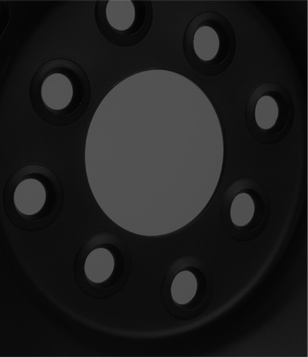What is ET/Offset?
The ET of a wheel is the horizontal distance between the mounting face of the wheel and the centreline measured in mm. A positive ET means that the mounting face is positioned towards the road facing side of the vehicle whilst a negative ET means that the mounting face is inboard on the vehicle.
Why is ET important?
The ET determines how the wheel will fit on the vehicle. A positive ET will push the wheel back towards the suspension whereas a negative ET will push the wheel outboard of the wheel arches. A wheel with an incorrect ET could cause issues with rubbing on the suspension or overstepping the wheel arch which is illegal.
What is back depth?
Back depth is the horizontal distance between the mounting face and the back of the wheel measured in mm. This distance is determined by the ET and width of the wheel. Back depth is a key indicator in determining whether a wheel will fit a vehicle or not. If the back depth is too great then the wheel will foul the suspension. The amount of acceptable back depth will vary between individual vehicles.
What is PCD?
PCD (Pitch Circle Diameter) is the diameter of the imaginary circle drawn through the centre of the bolt holes. The PCD on the wheel you purchase will need to match that of the vehicle you are fitting it to.
E.g. a 4×100 PCD consists of 4 bolts in a circle of 100mm diameter.
What is Centre Bore?
Centre Bore is the diameter of the hole at the centre of the wheel measured in mm. On a hub centric vehicle the centre bore will fit over a lip on the hub to locate the wheel before the nuts are tightened.
Do I need a spigot ring?
If the centre bore diameter of the wheel doesn’t match that of the lip on the hub then a spigot ring can be purchased in order to rectify this.
A spigot ring has the same outside diameter as the centre bore and varying sizes can be purchased to fit specific vehicles.
Why Steels?
Steels provide a classic look routed in British automotive history.
Steel wheels offer a significant strength advantage over magnesium and aluminium alloys, making them a robust and reliable choice, especially for 4×4 vehicles.
Steels offer an inexpensive, stylish and exclusive alternative to alloys.
How are our wheels produced?
Our wheels are handmade with care from nothing more than two steel blanks. Our experienced operators perform between 20-30 forming operations to create a perfect hand crafted steel wheel.
Which bolts do I require?
Our wheels are designed with a 60° conical nut seat with a specified diameter based upon the vehicles they are made to fit.
The technical information provided on the product information sheet will show which bolts are required.
The bolts you purchase will have to match the diameter and thread pitch of the holes in your wheel hub.
What do the terms stand for in the wheel size designation?
E.g. 8.5Jx16” H2.
The first term relates to the width of the wheel in inches, the J denotes the rim bead profile shape.
16” is the diameter of the wheel.
H2 relates to the amount of humps in the rim profile. H2 means that the rim profile has a double hump profile. This ensures that the tyre fits the rim properly and adds stiffness to the rim.
Which tyres should I fit to my new wheels?
E.g. 225/55 R 17 97 W
225 refers to tyre width in mm, in this case 225mm.
55 indicates the aspect ratio of the tyre, i.e. the height of the sidewall expressed as a percentage of the tread width.
R: refers to the internal construction of the tyre. R denotes a radial tyre; the plies of tyre cord extend across the casing from the bead.
17 refers to the inner diameter of the tyre, this should match the outer diameter of the wheel.
97 is the load index, this refers to a value in an index table. E.g. load index 97 equates to a maximum load of 730kg on the tyre.
W is the speed rating of the tyre or the maximum speed at which a tyre can safely carry a load. A=lowest and Y=highest.
How will I know if the wheels will fit my vehicle?
The product information sheets should contain basic fitment information about the wheel. If you are unsure you can contact our technical support team for more information.
Refer to diagram below to and attempt to measure wheel fitment yourself, again contact our technical support team if you require assistance.

I can’t find a wheel size to match my specification; can you produce a wheel that does?
We can make custom wheels to order, for more technical information and prices send an email to enquiry@wellerwheels.com or call us on 01527506047.
What is a rolled edge?
When forming the wheel rim, we add material to the rim edge which is then rolled into an impact resistant profile. A process unique to Weller and developed for Motorsport. Use only adhesive balancing weights, knock-on steel wheel balancing weights can’t be used.








